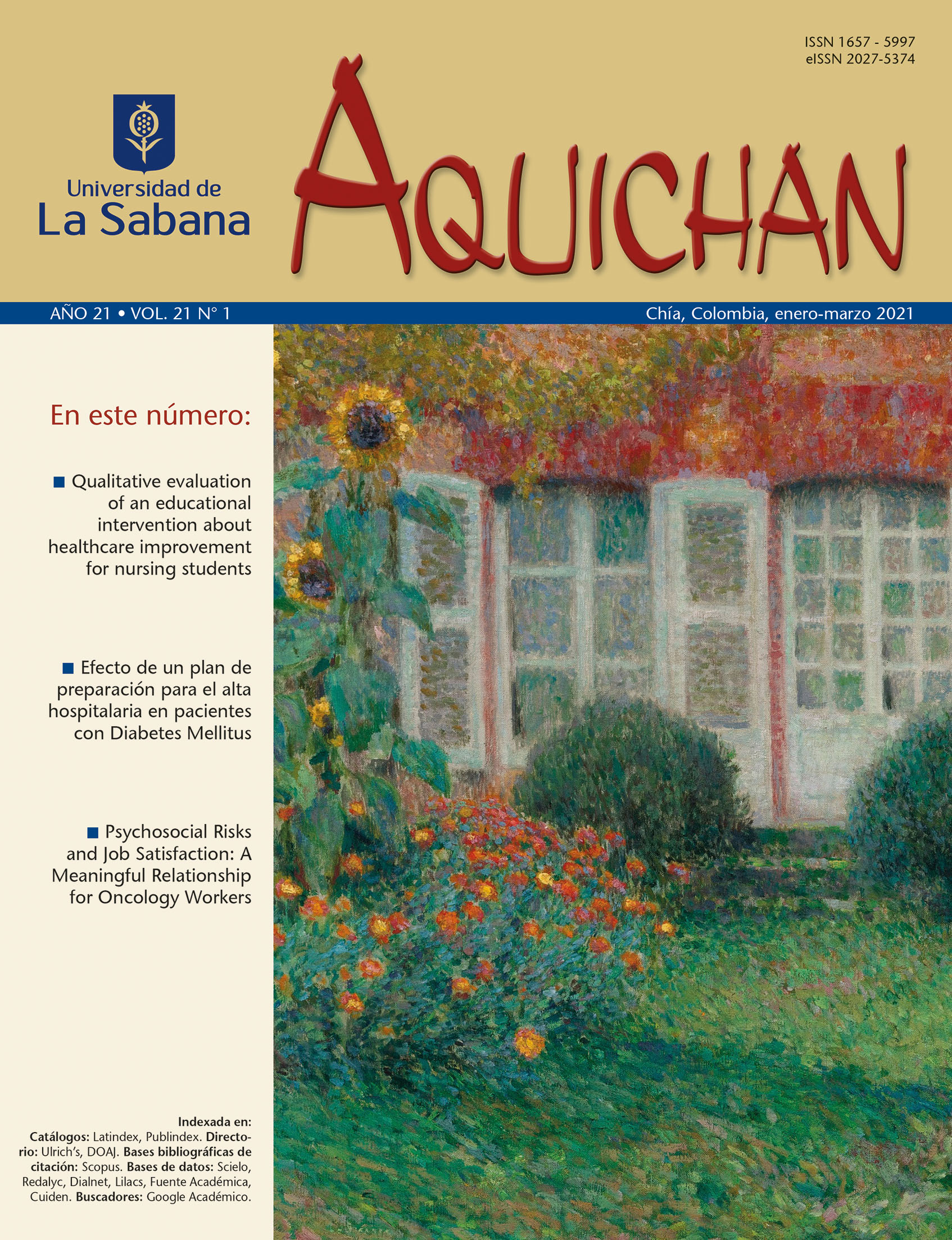Analysis of Repeated Violence Against Older Adults in a Brazilian State
DOI:
https://doi.org/10.5294/aqui.2021.21.1.8Keywords:
Violence, elder abuse, recidivism, mandatory reporting, epidemiological monitoringAbstract
Objective: To identify notified cases of repeated violence against older adults and its association with the characteristics of the victims, of the aggressor, and the aggression.
Materials and methods: A cross-sectional study was conducted based on data recorded in the Information System for Notifiable Health Problems on interpersonal repeated violence perpetrated against older adults between 2011 and 2018 in Espírito Santo, Brazil. The data were analyzed employing Poisson multiple regression with robust variance.
Results: The frequency of repeated violence was 50.1 % (95 % CI: 47.7-52.6). Being 80 years old or more, presenting disabilities or disorders, and having suffered violence by partners and/or children were associated with this condition in both genders. In aged men, violence was more frequently perpetrated by two or more aggressors and during the day, whereas aged women were more frequently assaulted in urban areas.
Conclusion: The high frequency of repeated violence and the associations with the characteristics studied reflect the need for care to older adults with disabilities or disorders and the possible signs of burden in family caregivers that may result in situations of violence. Actions aimed at early detection and adequate assistance to the victims and to the aggressors are important to avoid the chronicity of the condition.
Downloads
References
Orfila F, Coma-Solé M, Cabanas M, Cegri-Lombardo F, Moleras-Serra A, Pujol-Ribera E. Family caregiver mistreatment of the elderly: Prevalence of risk and associated factors. BMC Public Health. 2018;18(1):167. DOI: https://doi.org/10.1186/s12889-018-5067-8
Minayo MCS, Souza ER, Silva MMA, Assis SG. Institutionalizing the theme of violence within Brazil’s national health system: Progress and challenges. Cien Saude Colet. 2018;23(6):2007-16. DOI: http://dx.doi.org/10.1590/1413-81232018236.04962018
Secretaria de Direitos Humanos da Presidência da República (Brasil). Manual de enfrentamento à violência contra a pessoa idosa — é possível prevenir, é necessário superar. Brasília (DF): Secretaria dos Direitos Humanos da Presidência da República; 2014. Disponível em: https://bibliotecadigital.mdh.gov.br/jspui/handle/192/343
World Health Organization. Ageing and life-course: Elder abuse; 2019. Available from: https://www.who.int/ageing/projects/elder_abuse/en/
World Health Organization. Elder abuse: The health sector role in prevention and response. Geneva: World Health Organization; 2016. Available from: https://www.who.int/violence_injury_prevention/violence/elder_abuse/WHO_EA_ENGLISH_2017-06-13.pdf
Dong XQ. Elder abuse: Systematic review and implications for practice. J Am Geriatr Soc. 2015;63(6):1214-38. DOI: https://doi.org/10.1111/jgs.13454
Acierno R, Hernandez-Tejada MA, Anetzberger GJ, Loew D, Muzzy W. The national elder mistreatment study: An 8-year longitudinal study of outcomes. J Elder Abuse Negl. 2017;29(4);254-69. DOI: https://doi.org/10.1080/08946566.2017.1365031
Yon Y, Mikton CR, Gassoumis ZD, Wilber KH. Elder abuse prevalence in community settings: A systematic review and meta-analysis. Lancet Glob Health. 2017;5(2):e147-56. DOI: https://doi.org/10.1016/S2214-109X(17)30006-2
Pillemer K, Burnes D, Riffin C, Lachs MS. Elder abuse: Global situation, risk factors, and prevention strategies. Gerontologist. 2016;56(suppl 2):194-205. DOI: https://doi.org/10.1093/geront/gnw004
Blay SL, Laks J, Marinho V, Figueira I, Maia D, Coutinho ESF et al. Prevalence and correlates of elder abuse in São Paulo and Rio de Janeiro. J Am Geriatr Soc. 2017;65(12):2634-8. DOI: https://doi.org/10.1111/jgs.15106
Bolsoni CC, Coelho EBS, Giehl MWC, d’Orsi E. Prevalência de violência contra idosos e fatores associados, estudo de base populacional em Florianópolis, SC. Rev Bras Geriatr Gerontol. 2016;19(4):671-82 DOI: http://dx.doi.org/10.1590/1809-98232016019.150184
Ally EZ, Laranjeira R, Viana MC, Pinsky I, Caetano R, Mitsuhiro S et al. Intimate partner violence trends in Brazil: Data from two waves of the Brazilian National Alcohol and Drugs Survey. Braz J Psychiatry. 2016;38(2):98-105. DOI: http://dx.doi.org/10.1590/1516-4446-2015-1798
Friedman LS, Avila S, Rizvi T, Partida R, Friedman D. physical abuse of elderly adults: Victim characteristics and determinants of revictimization. J Am Geriatr Soc. 2017;65(7):1420-6. DOI: http://dx.doi.org/10.1111/jgs.14794
Camacho ACLF, Alves RR. Mistreatment against the elderly in the nursing perspective: An integrative review. J Nurs UFPE online. 2015;9(suppl 2):927-35. DOI: http://dx.doi.org/10.5205/1981-8963-v9i2a10418p927-935-2015
Veloso MMX, Magalhães CMC, Dell’Aglio DD, Cabral IR, Gomes MM. Notificação da violência como estratégia de vigilância em saúde: perfil de uma metrópole do Brasil. Cien Saude Colet. 2013;18(5):1263-72. DOI: http://dx.doi.org/10.1590/S1413-81232013000500011
Burnes D, Elman A, Feir BM, Rizzo V, Chalfy A. Courtney E et al. Exploring risk of elder abuse revictimization: Development of a model to inform community response interventions. J Appl Gerontol. 2020;733464820933432. DOI: https://doi.org/10.1177/0733464820933432
Rodrigues RAP, dos Santos AMR, Pontes MLF, Monteiro EA, Fhon JRS, Bolina AF et al. Report of multiple abuse against older adults in three Brazilian cities. PLoS ONE. 2019;14(2):e0211806. DOI: https://doi.org/10.1371/journal.pone.0211806
Ministério da Saúde do Brasil. VIVA: instrutivo de notificação de violência interpessoal e autoprovocada. Brasília (DF): Ministério da Saúde; 2016. Disponível em: https://bvsms.saude.gov.br/bvs/publicacoes/viva_instrutivo_violencia_interpessoal_autoprovocada_2ed.pdf
Mascarenhas MDM, Andrade SSCA, Neves ACM, Pedrosa AAG, Silva MMA, Malta DC. Violência contra a pessoa idosa: análise das notificações realizadas no setor saúde — Brasil, 2010. Cien Saude Colet. 2012;17(9):2331-41. DOI: http://dx.doi.org/10.1590/S1413-81232012000900014
Lopes EDS, Ferreira ÁG, Pires CG, Moraes MCS, D’Elboux MJ. Elder abuse in Brazil: An integrative review. Rev Bras Geriatr Gerontol. 2018;21(5):628-38. DOI: http://dx.doi.org/10.1590/1981-22562018021.180062
Couto AM, Caldas CP, Castro EAB. Home care for dependent elderly patients by caregivers with overload and stress. J Res Fundam Care. Online. 2019;11(4):944-50. DOI: http://dx.doi.org/10.9789/2175-5361.2019.v11i4.944-950
Bernardino IM, Barbosa KGN, Nóbrega LM, Cavalcante GMS, Ferreira EF, d’Ávila S. Violência contra mulheres em diferentes estágios do ciclo de vida no Brasil: um estudo exploratório. Rev Bras Epidemiol. 2016;19(4):740-52. DOI: https://doi.org/10.1590/1980-5497201600040005
Rocha RC, Cortes MCJW, Dias EC, Gontijo ED. Violência velada e revelada contra idosos em Minas Gerais-Brasil: análise de denúncias e notificações. Saúde Debate. 2018;42(4):81-94. DOI: http://dx.doi.org/10.1590/0103-11042018s406
Downloads
Published
How to Cite
Issue
Section
License
Copyright (c) 2021 Aquichan

This work is licensed under a Creative Commons Attribution-ShareAlike 4.0 International License.
1. Proposed Policy for Journals That Offer Open Access
Authors who publish with this journal agree to the following terms:
- The journal and its papers are published with the Creative Commons License Attribution-NonCommercial-NoDerivatives 4.0 International (CC BY-NC-ND 4.0). You are free to share copy and redistribute the material in any medium or format if you: give appropriate credit, provide a link to the license, and indicate if changes were made; don’t use our material for commercial purposes; don’t remix, transform, or build upon the material.









